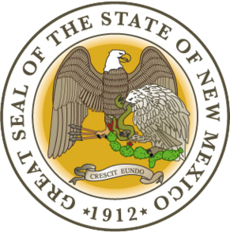Which States Host the Most Competitive Gubernatorial Elections?
New Mexico, Alaska, and Indiana have provided the tightest gubernatorial races in the nation since 1900; over the last three decades: Mississippi, Illinois, and Virginia

If history has its say, the gubernatorial contest in New Mexico between Democratic Lieutenant Governor Diane Denish and Republican Dona Ana County District Attorney Susana Martinez will go down to the wire as the most competitive race in the country in 2010.
The New Mexico race, along with several others among the more than three dozen states with gubernatorial elections on the ballot this November, has been categorized as a ‘toss-up’ by most political analysts as the campaign soon heads into the final 60 days.
And while term-limited Governor Bill Richardson won the office by an average of 27 points in 2002 and 2006, those contests are aberrations in the annals of gubernatorial electoral history in the Land of Enchantment.
A Smart Politics analysis of nearly 1,800 gubernatorial elections since 1900 finds that while the average margin of victory in such contests nationwide has been 21.0 points, New Mexico has averaged a highly competitive 7.5-point victory margin across its 38 contests held since statehood.
In fact, an astounding 79 percent of New Mexico’s races for governor have been decided by less than 10 points (30 of 38) – best in the nation – with 47 percent by less than 5 points (18).
However, despite this history of highly competitive races for the state’s chief executive office, including 20 of 22 races decided by single digits from 1942 through 1998, New Mexico Democrats have consistently edged out Republicans in these tight contests – winning nearly twice as many elections as the GOP (25 to 13).

Richardson’s 2008 win marked the largest margin of victory in state history while his 2002 triumph was the third largest, behind Democrat Jack Campbell’s 20.4-point victory in 1964.
But New Mexico isn’t the only state that has provided election watchers with interesting gubernatorial contests cycle after cycle.
The 9.0-point average margin of victory across Alaska’s 13 gubernatorial elections since statehood rank the Last Frontier State as the second most competitive in the nation, with 10 of these races decided by single digits (77 percent).
Adding to the drama and tight races in Alaska have been the prominence of strong third party candidates (e.g. Wally Hickel winning in 1990) as well as write-in campaigns that have defeated endorsed major party candidates, landing write-in candidacies in second place twice (Wally Hickel in 1978 and Robin Taylor in 1998).
Rounding out the Top 10 most competitive states for gubernatorial elections since 1900 are Indiana (#3, 9.5 point average margin of victory), Ohio (#4, 10.0 points), Missouri (#5, 10.1 points), Connecticut (#6, 10.5 points), New Jersey (#6, 10.5 points), Hawaii (#6, 10.5 points), Illinois (#9, 10.7 points), and New York (#10, 11.1 points).
And what state has served up the least competitive gubernatorial elections over the last 110 years?
Although four of its last five races have been decided by single digits, the State of Georgia has hosted the most lopsided contests in the nation overall, with an average victory margin of 75.1 points across its 39 gubernatorial elections since 1900.
Of course, due to the dominance of the Democratic Party for decades upon decades in the South, the winner of the Democratic primary often went uncontested in the general election in many southern states – driving up this gaudy margin of victory tally.
As a result, despite a gradual rise in competitiveness and then power for the GOP in the region beginning in the mid-1960s, 11 of the 12 states with the largest average margin of victories in gubernatorial races since 1900 are southern states.
Georgia, at #50, is followed by South Carolina (#49, 72.3 points), Louisiana (#48, 63.7 points), Mississippi (#47, 62.0 points), Texas (#46, 50.0 points), Alabama (#45, 49.2 points), Arkansas (#44, 45.5 points), Florida (#43, 37.0 points), Virginia (#41, 26.6 points), Tennessee (#40, 24.4 points), and North Carolina (#39, 21.8 points).
Margin of Victory in Gubernatorial Races Since 1900 by State
|
Rank
|
State
|
#
|
MoV
|
# < 10 pts
|
% < 10 pts
|
|
1
|
New Mexico
|
38
|
7.5
|
30
|
78.9
|
|
2
|
Alaska
|
13
|
9.0
|
10
|
76.9
|
|
3
|
Indiana
|
28
|
9.5
|
14
|
50.0
|
|
4
|
Ohio
|
41
|
10.0
|
23
|
56.1
|
|
5
|
Missouri
|
28
|
10.1
|
14
|
50.0
|
|
6
|
Connecticut
|
40
|
10.5
|
24
|
60.0
|
|
6
|
New Jersey
|
32
|
10.5
|
16
|
50.0
|
|
6
|
Hawaii
|
13
|
10.5
|
7
|
53.8
|
|
9
|
Illinois
|
28
|
10.7
|
14
|
50.0
|
|
10
|
New York
|
37
|
11.1
|
19
|
51.4
|
|
11
|
West Virginia
|
28
|
11.3
|
19
|
67.9
|
|
11
|
Massachusetts
|
54
|
11.3
|
33
|
61.1
|
|
13
|
Washington
|
28
|
11.5
|
15
|
53.6
|
|
14
|
Pennsylvania
|
27
|
12.0
|
16
|
59.3
|
|
14
|
Idaho
|
39
|
12.0
|
22
|
56.4
|
|
16
|
Kentucky
|
28
|
12.1
|
15
|
53.6
|
|
17
|
Montana
|
28
|
12.2
|
15
|
53.6
|
|
18
|
Wyoming
|
30
|
12.4
|
14
|
46.7
|
|
19
|
Kansas
|
46
|
12.6
|
26
|
56.5
|
|
20
|
Michigan
|
44
|
13.2
|
22
|
50.0
|
|
21
|
Delaware
|
28
|
13.4
|
18
|
64.3
|
|
22
|
Arizona
|
39
|
13.5
|
22
|
56.4
|
|
23
|
Minnesota
|
43
|
13.6
|
20
|
46.5
|
|
24
|
Colorado
|
42
|
13.7
|
16
|
38.1
|
|
25
|
Nebraska
|
44
|
13.9
|
23
|
52.3
|
|
25
|
Iowa
|
45
|
13.9
|
17
|
37.8
|
|
27
|
Rhode Island
|
57
|
14.0
|
27
|
47.4
|
|
27
|
New Hampshire
|
55
|
14.0
|
26
|
47.3
|
|
29
|
Maine
|
43
|
14.1
|
22
|
51.2
|
|
30
|
Maryland
|
27
|
14.2
|
13
|
48.1
|
|
30
|
Oregon
|
29
|
14.2
|
12
|
41.4
|
|
32
|
Wisconsin
|
45
|
14.4
|
19
|
42.2
|
|
33
|
Oklahoma
|
26
|
15.0
|
10
|
38.5
|
|
34
|
Utah
|
28
|
15.5
|
12
|
42.9
|
|
35
|
Nevada
|
27
|
17.4
|
11
|
40.7
|
|
36
|
California
|
28
|
17.9
|
10
|
35.7
|
|
37
|
South Dakota
|
46
|
18.0
|
13
|
28.3
|
|
38
|
North Dakota
|
45
|
20.5
|
17
|
37.8
|
|
39
|
North Carolina
|
28
|
21.8
|
7
|
25.0
|
|
40
|
Tennessee
|
40
|
24.4
|
10
|
25.0
|
|
41
|
Virginia
|
28
|
26.6
|
6
|
21.4
|
|
42
|
Vermont
|
55
|
26.8
|
9
|
16.4
|
|
43
|
Florida
|
29
|
37.0
|
3
|
10.3
|
|
44
|
Arkansas
|
50
|
45.5
|
5
|
10.0
|
|
45
|
Alabama
|
27
|
49.2
|
3
|
11.1
|
|
46
|
Texas
|
46
|
50.7
|
9
|
19.6
|
|
47
|
Mississippi
|
27
|
62.0
|
5
|
18.5
|
|
48
|
Louisiana
|
27
|
63.7
|
2
|
7.4
|
|
49
|
South Carolina
|
34
|
72.3
|
6
|
17.6
|
|
50
|
Georgia
|
39
|
75.1
|
5
|
12.8
|
|
|
Total
|
1,777
|
20.9
|
746
|
42.0
|
Note: Table compiled by Smart Politics.
The only non-southern state with a history of blow-out gubernatorial races over the last century is Vermont, coming in at #42.
The Green Mountain State, which has held 55 elections since 1900, has had an average victory margin of 26.8 points, with just nine of these decided by single digits (16 percent).

But because the partisan voting behavior in a state’s electorate can change drastically over time (e.g. in the South), taking only the long view of history is not necessarily a good predictor of what gubernatorial races are likely to be competitive in 2010.
As such, the table below lists the Top 10 most competitive states in gubernatorial races since both 1965 (the year after the landmark 1964 Civil Rights Act) and 1980 (the beginning of the Reagan Revolution).
States with the Top 10 Narrowest Average Margins of Victory in Gubernatorial Elections Since 1965 and 1980
|
Rank
|
1965-2009
|
MoV
|
1980-2009
|
MoV
|
|
1
|
Alaska
|
8.4
|
Mississippi
|
8.7
|
|
2
|
New Mexico
|
8.8
|
Illinois
|
9.4
|
|
3
|
Virginia
|
9.0
|
Virginia
|
9.6
|
|
4
|
Illinois
|
9.7
|
Alabama
|
9.8
|
|
5
|
Maine
|
10.3
|
Iowa
|
10.1
|
|
6
|
Washington
|
10.6
|
Minnesota
|
10.9
|
|
7
|
Hawaii
|
10.7
|
Alaska
|
11.1
|
|
8
|
Arizona
|
11.3
|
Washington
|
11.2
|
|
9
|
Iowa
|
11.3
|
North Carolina
|
11.3
|
|
10
|
North Carolina
|
11.7
|
Hawaii
|
11.5
|
Note: Table compiled by Smart Politics.
As the table above demonstrates, over the past three decades some of the most competitive races for governor have taken place in the South.
From 1980 to 2009, the State of Mississippi has provided the narrowest average margin of victory at 8.7 points per election.
Fellow southern states Virginia (#3, 9.6 points), Alabama (#4, 9.8 points), and North Carolina (#9, 11.3 points) also rank in the Top 10 during this 30-year span.
Overall, the average margin of victory in the 16-state southern region (as designated by the U.S. Census Bureau), has been 38.9 points in the South since 1900, but just 18.7 points since 1965 and 16.7 points since 1980.
By contrast, every other region in the United States has seen its average margin of victory in gubernatorial contests increase during this span, with the nine-state eastern region of the country home to the largest average victory margin since 1980 at 18.7 points.
Average Margin of Victory in Gubernatorial Elections by Region and Time Period
|
Region
|
1900-2009
|
1965-2009
|
1980-2009
|
|
East
|
14.4
|
16.8
|
18.7
|
|
Midwest
|
13.7
|
14.2
|
16.2
|
|
South
|
38.9
|
18.7
|
16.7
|
|
West
|
13.0
|
14.4
|
16.0
|
Note: State are grouped into regions as designated by the U.S. Census Bureau. Table compiled by Smart Politics.
However, one southern state continues to rank as the least competitive in the nation – Louisiana.
The Pelican State has had the largest victory margins since both 1965 (36.5 points) and 1980 (35.5 points), as depicted in the table below.
States with Top 10 Largest Average Margins of Victory in Gubernatorial Elections Since 1965 and 1980
|
Rank
|
1965-2009
|
MoV
|
1980-2009
|
MoV
|
|
41
|
Georgia
|
20.8
|
New York
|
21.3
|
|
42
|
Rhode Island
|
21.4
|
South Dakota
|
21.4
|
|
43
|
Maryland
|
21.8
|
Utah
|
21.6
|
|
44
|
Nevada
|
21.8
|
Nebraska
|
21.9
|
|
45
|
Delaware
|
22.1
|
Rhode Island
|
22.8
|
|
46
|
Tennessee
|
22.1
|
New Hampshire
|
22.8
|
|
47
|
Arkansas
|
22.6
|
Nevada
|
23.5
|
|
48
|
Utah
|
23.2
|
North Dakota
|
24.0
|
|
49
|
Alabama
|
25.0
|
Delaware
|
28.1
|
|
50
|
Louisiana
|
36.5
|
Louisiana
|
35.5
|
Note: Table compiled by Smart Politics.
The preceding table reflects the geographic shift to the northeast for where many of the nation’s least competitive gubernatorial races can be found (e.g. New York (#41, 21.3 points), Rhode Island (#45, 22.8 points), and New Hampshire (#46, 22.8 points)).
Follow Smart Politics on Twitter.

1. LA: Perhaps the adoption of the all-candidate elections, commenced with the 1975 elections at the behest of onetime political icon Edwin Edwards as he was then vying for a second term, has played a part in the continued dearth of competition? (All of the other fellow Southern states have stuck with the traditional nominations by the parties.)
2. “…EIGHTH in a series…” Either it is a slight counting error, or the author of the gubernatorial series decided to retroactively exclude the 12 of 08 2010 piece (“…Handel and Anderson Kelliher…”) from it. Fine by me either way!
2.